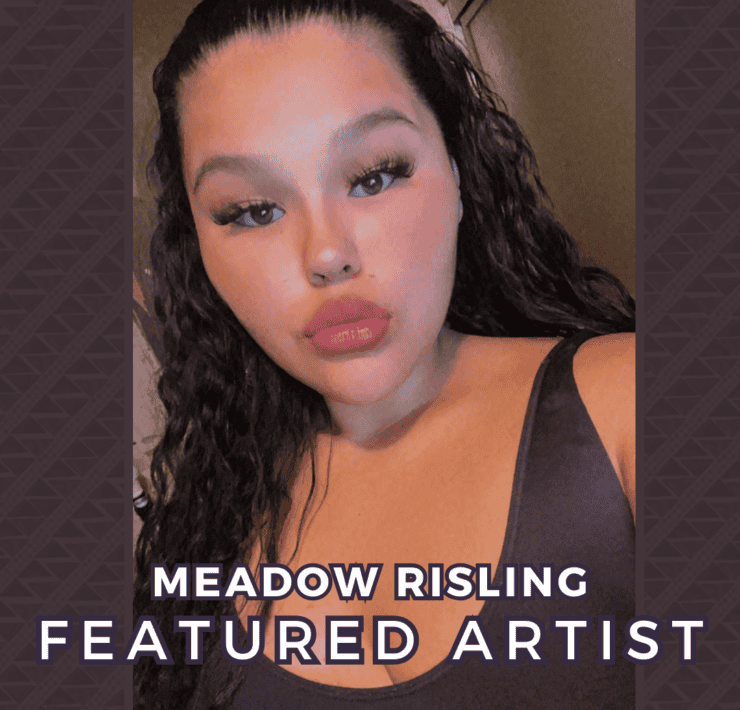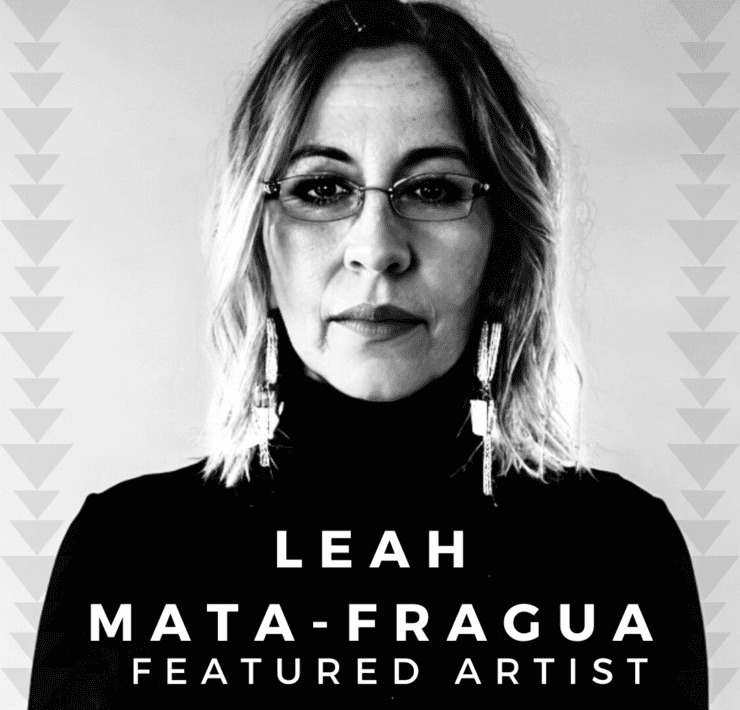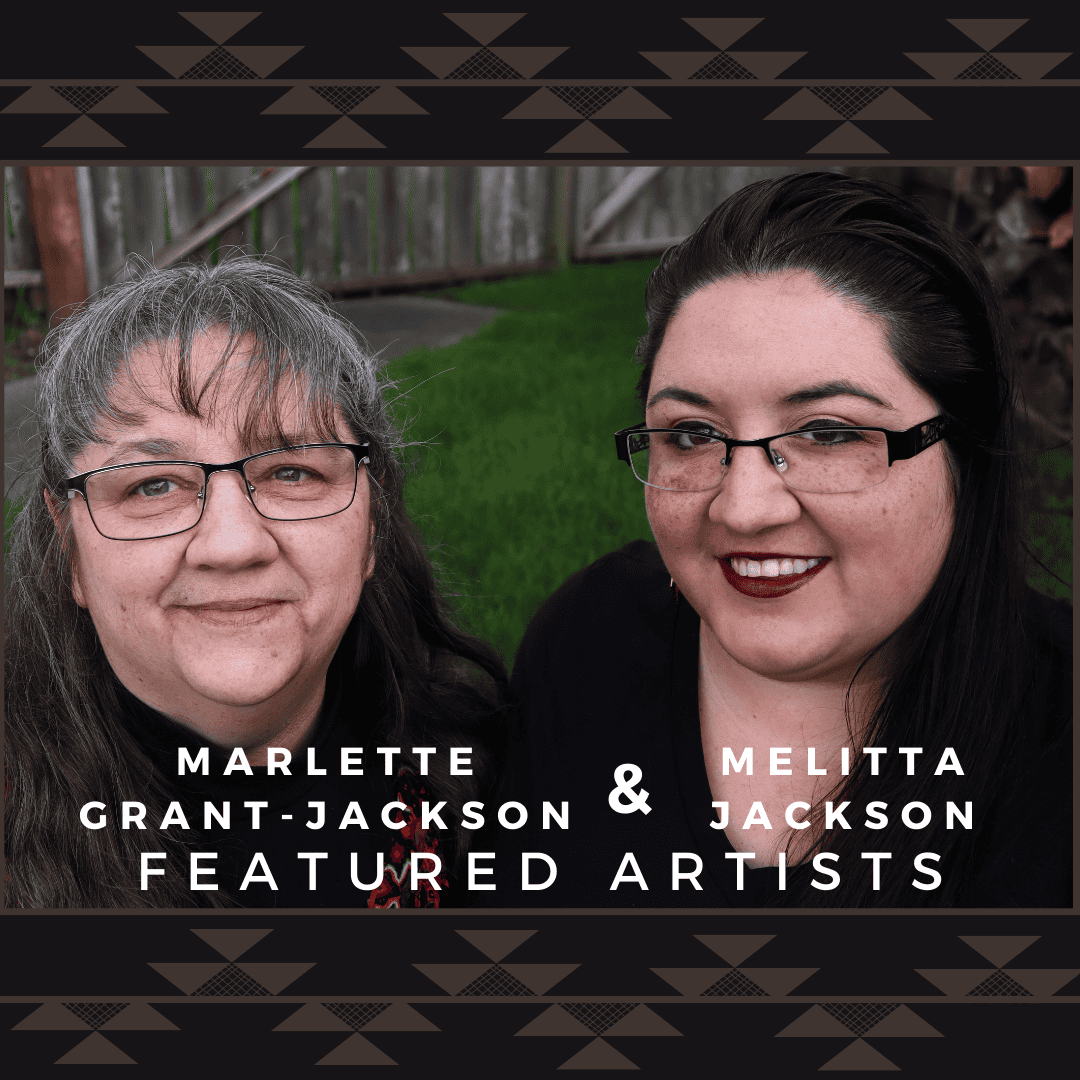
by Tavi Lorelle Carpenter
This is a special week of celebrating Native Artists; for the first time, we will be celebrating two artists! Mother and daughter Marlette Grant-Jackson and Melitta Jackson, enrolled Yurok tribal members, are incredibly talented and inspiring artists working in various mediums. Both established as individual artists, they sometimes collaborate, including their Etsy store, where they sell prints, canvases, cups, blankets, and notecards.
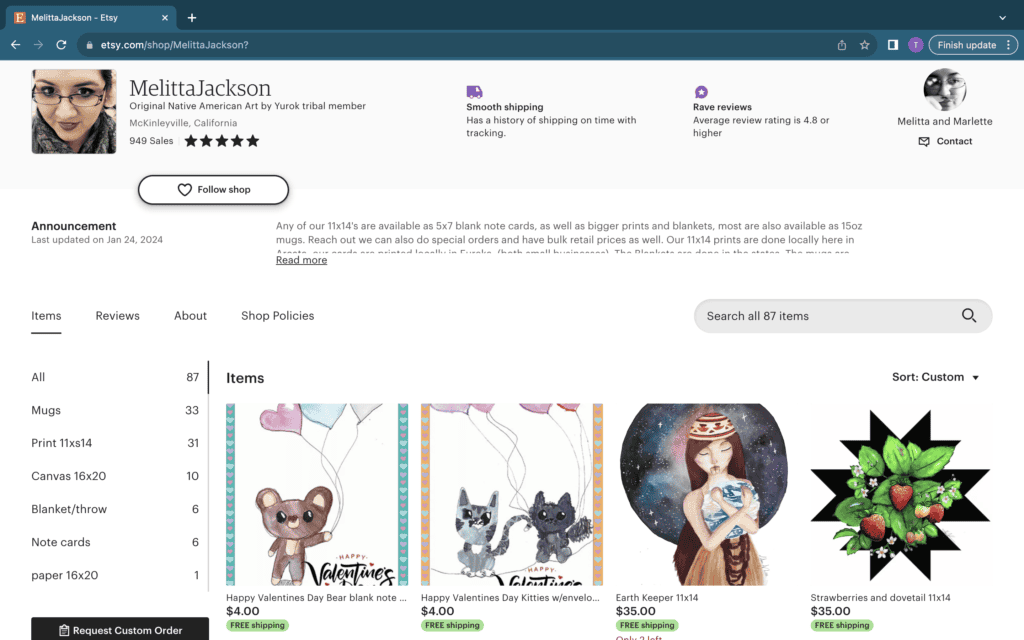
Incredibly prolific, Marlette and Melitta are exceptionally down to earth, grounded in their artistry in whatever form they happen to be exploring. For Marlette, it seems vital to begin with her regalia work; there is even a short documentary about her for Native Women’s Collective talking about the dance dress she made for her daughter’s flower dance ceremony. Unique in the amount of beargrass she chose to use, it is an absolutely beautiful fancy dress highlighting her incredible talent and skill. Something she gained from her family, elders, and teachers.
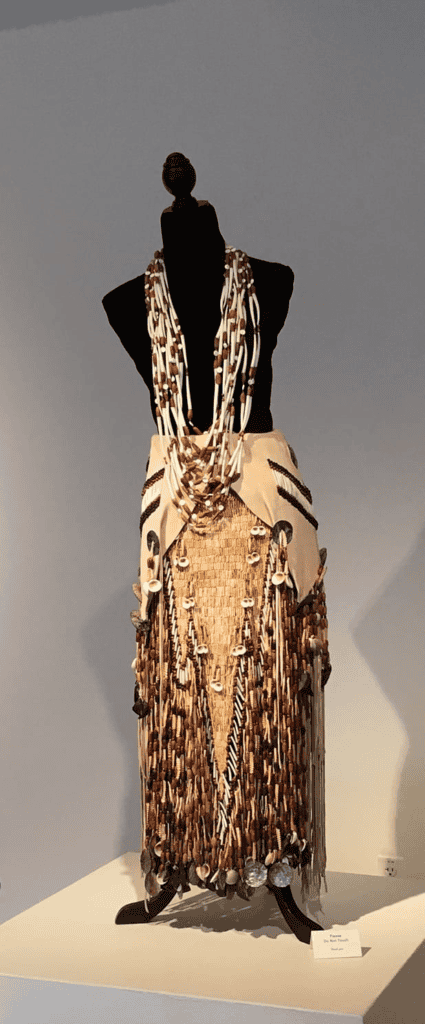
for her daughter Melitta Jackson,
image provided by the artist.
“I’ve had wonderful mentors willing to share their talents,” Marlette told me when I asked how she started learning. “My auntie Josephine Peters-she wrote the book After the First Full Moon in April. She was an herbalist, basket weaver, and dress maker. she was probably my first cultural inspiration. I received my first set of abalone hair ties made by her, and the first brush dance dress I wore was one of hers. My Grandpa Jimmy, gave me a bundle of beargrass when I was 18, and told me to get busy. And then there were other community members that taught me different skills. Debbie McConnel, for example, started a Dress making class around 1997. [Debbie McConnell] is a basket weaver, a dressmaker and artist. Wendy “Poppy” George, Tweet Peters, and Kateri Masten offered basket weaving classes and gathering trips to get Willow, Spruce, and Woodwardia. My Aunt Laura Lee included me in outings to gather pine nuts, maple bark, bear grass, acorns, and helped me cut my first deerskin to make my daughter’s dress. I think that you create a tighter community when you gather/collect together, and learn to process all the materials you work with from start to finish. Unless you’re going to go out and buy everything. [But] most of us go out and collect all our own [materials]
Marlette has never been shy about thinking creatively in regard to her regalia work. She shared with me an example of why she started creating open-weave capes: “I met with regalia holders to look at the items they had, dentalium capes for example. I took measurements, looked at the pieces closely to see how they were made. Then I talked with some young women that dance in Brush dances and asked them what they would like. I was told something cooler, the ones that were sewn on cloth were too hot to wear in the pit. Something easier to put on, they didn’t like having to wait to be dressed to dance.”
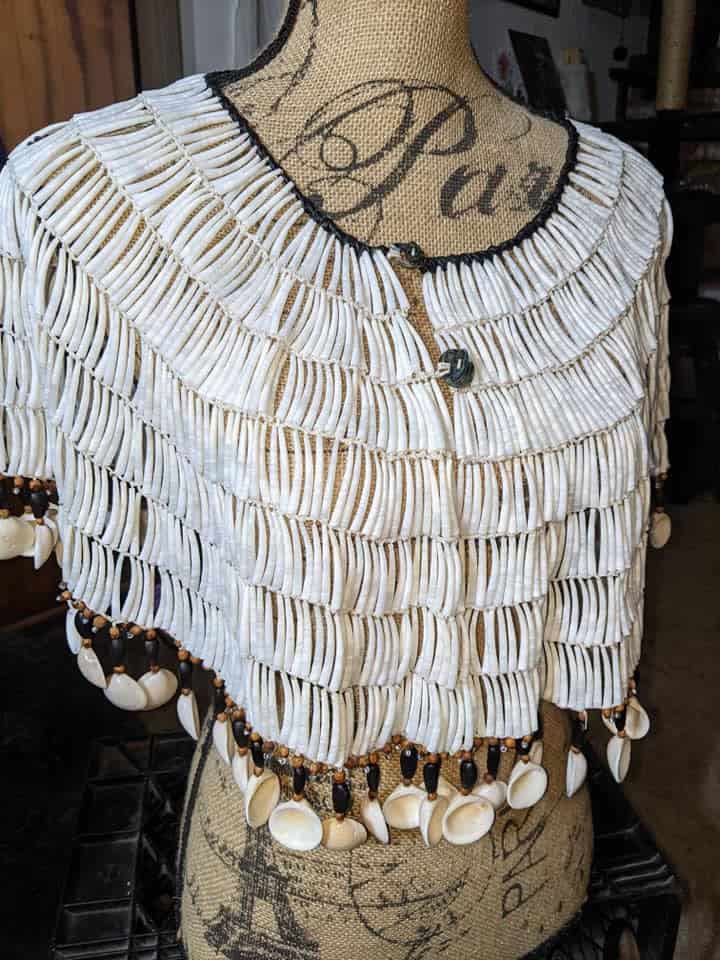
image provided by the artist.
At the same time, her artistry remains deeply grounded in traditional cultural ways.
“Most of my [artwork] comes from ceremony, and you’re not supposed to take pictures, so it’s just my interpretation of what those ceremonies are. Having been in a family [where] my uncle was a dance leader, my dad’s sister married into that family; it’s my interpretation of the spiritual ceremonies that we actually hold and that I participated in; it’s my experience.”

image provided by the artist.
Melitta, Marlette’s daughter, said that her artistry is rooted in her family’s connection to creativity. As she sees it, art has always been a central part of her identity.
“I was always creative, whether just because that’s just how I was [or] because my mom was always creative and my grandmother was always creative. It just felt like it was something I have always been doing. Even as a kid, I was constantly painting something or creating something and making messes everywhere!”
Melitta started down a more serious art path in high school, where she had the opportunity to do an arts program that offered workshops during after-school hours. She credits that decision as central to introducing her to different art-making forms.
“I think it was really great in helping me find other mediums that I really liked and felt passionate about outside of just sketching in a sketch pad. It really opened my mind to a lot of aspects.”
Both Marlette and Melitta have taken other career paths aside from art that stemmed from wanting their creativity and artistic process to remain something joyous. This choice has also allowed them to be very exploratory in their art-making.
Mother and daughter are also very collaborative, each contributing their unique skills, whether in the art-making process or the Etsy store’s business side.
“With the artwork, Melitta does the detailed work of each one of the animals, and then I put the native flair. So, any basket designs that are [included]-because that’s what I would want. I would want [to make it] so that it shows that it’s indigenous, and it’s something that we use and something that is meaningful to us in this area.”
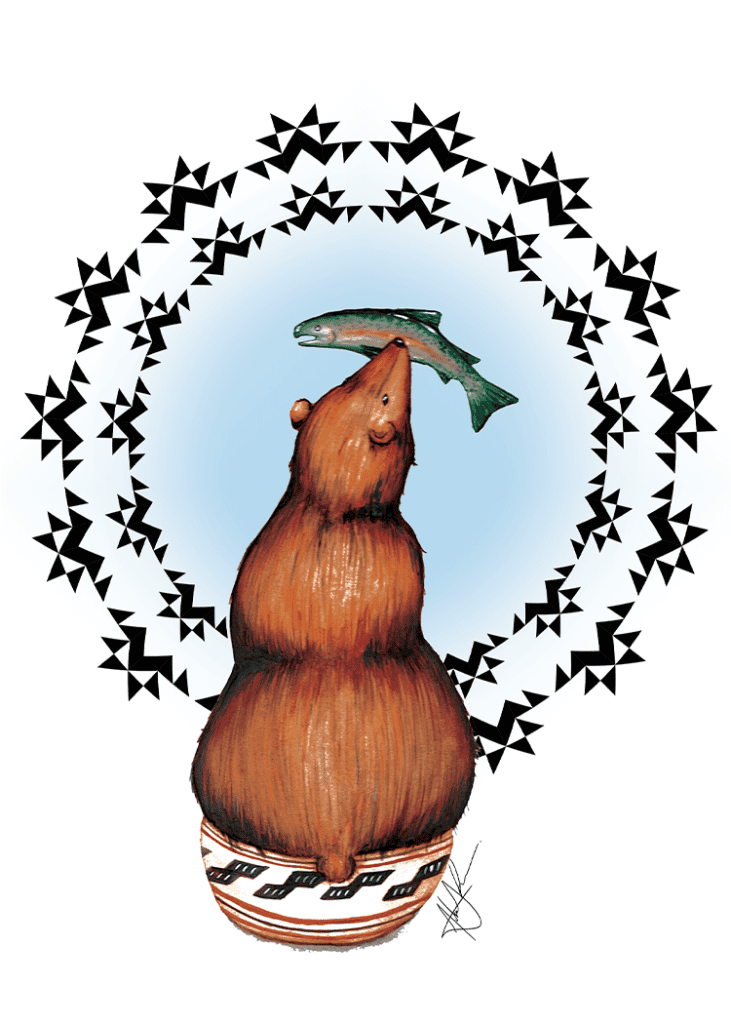
Melitta added that the critical part of their collaborative process is their honesty with one another.
“If something doesn’t look right, I’ll let her know,” Melitta told me. “I think we’re honest with each other to the point where we know there’s no hard feelings. Anytime I draw or illustrate anything, I will go to her for opinions because I know and expect the honest truth.”
Not that they always agree.
“[Melitta] has a tendency to want to do things in black and white, and I want to add color. So she doesn’t like that.” Marlette commented with a chuckle.
As both mother and daughter are so prolific, I wanted to know if any pieces, through the years, continued to stand out to them as being particularly meaningful.
“The first one would be Melitta’s dress, the one I did for her coming-of-age ceremony,” Marlette told me thoughtfully. This dress, which she had started on while Melitta was still a girl, utilized the beargrass given to her by her grandfather when she was 18.

image provided by the artist.
The second piece Marlette shared was something she had created in honor of her son’s memory that showed the man in the moon. She drew inspiration from Louisa McConnell, that’s on the cover of Shaunna Oleka McCovey’s book of poetry, The Smokehouse Boys.
“This is my take [of McConnell’s piece]. My son passed, and he left us each note, and [he] said that my dad, [his grandfather] had told him a story about the moon being a window to the other side. He told me he’d be watching us through the moon. So it made a different meaning for me, for the man in the moon. It’s like he’s watching us from the other side.”
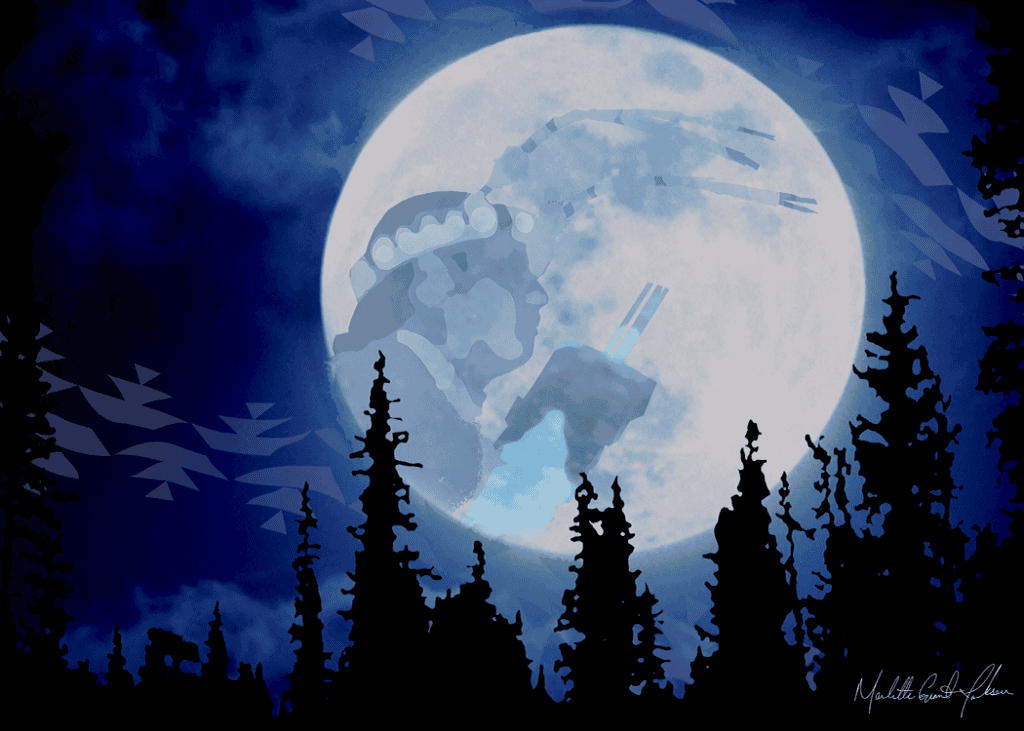
For Melitta, two projects stood out to her as being very special in her artistic journey. The first was an otter sculpture that she’d been commissioned to do by Jeff Black, a professor in wildlife at Cal Poly Humboldt. The project celebrated river otters returning from the brink of extinction due to the fur trade. One hundred artists were asked to decorate a fiberglass sculpture that would be auctioned off. Twelve of the local artists selected were Native artists from the area, including Melitta!
“The whole idea was that these otters [would] be on auction, and the funding would go towards the preservation of the otters. But the 12 otters that were done by Native artists weren’t going to be auctioned. The theme of it had to surround otters or resurgence.”
Melitta drew a parallel between the resurgence of otters and the resurgence of ceremonies; she decided her otter would be dressed in regalia for a flower ceremony, the coming-of-age ceremony for young girls becoming women after they start their period. Her own ceremony, where she wore the dress made for her by Marlette, was such a pivotal moment for her; it felt important to honor it with her artwork. But it was indeed a learning opportunity for her as well.
“I don’t typically work in sculpture or 3D. I have in the past, but it was more [projects for school]. This felt like an opportunity to push boundaries again. We had some leftover bark that someone had given us, and [as] my mom said, we like gathering things; I think we have all these gathered materials of bark, and pine nuts, and bear grass, and abalone, and we just kind of [keep] them until something comes up, which [was] lovely in this aspect.”
One challenge was figuring out how to get bluejay feathers for the veil.
“It is something that [a] girl wears in the flower dance because she’s in a vulnerable transition time that no one’s supposed to see her in that vulnerable state between girlhood and womanhood. I was trying to figure out how to collect it because it’s not a game bird at all. People were trying to help me figure it out.”
Through a series of fortunate events, Melitta was able to have access to the feathers she needed.
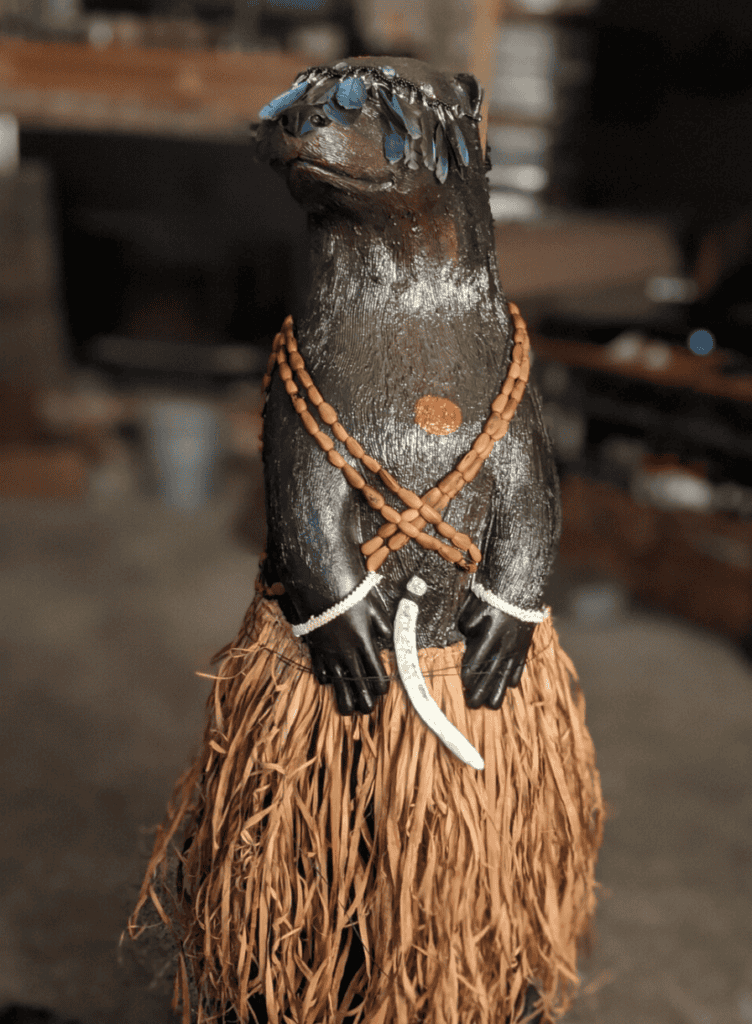
Melitta described how she enjoyed the process of figuring out how to create textures and work in a less familiar medium. She shared that this challenged her creatively, allowing her to expand her artistry.
“When something different like this comes along, [it] breathes some fresh air into doing art.”
Another notable project for Melitta was her mural for the 2020 Eureka Art Festival. Joined by a group of talented artists, Melitta’s mural, entitled “Run”, celebrated another aspect of the Flower Dance Ceremony. Completed in the height of the pandemic, she chose her subject out of a recognition of uncertainty surrounding the future with the additional understanding that we must all move forward.
“Because there was this fear, I ended up choosing this image of a flower girl running. She runs just after dawn and just before dusk. She also does a four-mile run with a father figure or someone who is to lead her through life. That was my inspiration for [the mural]. I wanted us to look at her back as she’s running and finding her own path.”

Having the opportunity to work with other local talented artists was extremely meaningful, particularly
“Working with other local native artists: Carl Avery, Alme Allen, Julian Lang, and Lyn Risling seeing their processes, getting their help and input almost every step of the way was just such an experience that I’m still wrapping my mind around! Just, overall grateful for the experience and that time I got to spend with them.”
Marlette and Melitta share a sense of willingness and bravery in their creativity, continuously open to the opportunity to do something different. This is made even more evident in their inspiring words of wisdom for other artists.
Marlette imparted the importance of not letting others discourage you by sharing a story from her early days of art-making.
“One of my first pieces, which was called ‘The High Dances’. I took it and thought, oh, I did this wonderful piece. I’ll take [it] to one of the local Native stores and see if they’ll sell [it] for me. The first thing I [was told] was, ‘Why do you think that you should have the right to be able to do that?’ I could believe [it]. I was literally laugh[ing]-crying because it’s like, did I just do something wrong? Because I did my interpretation of what our ceremonies are. It’s nobody in particular; it’s just representative of the ceremonies that we do. And I wholeheartedly believe in them. I wanted to share it with other people.”
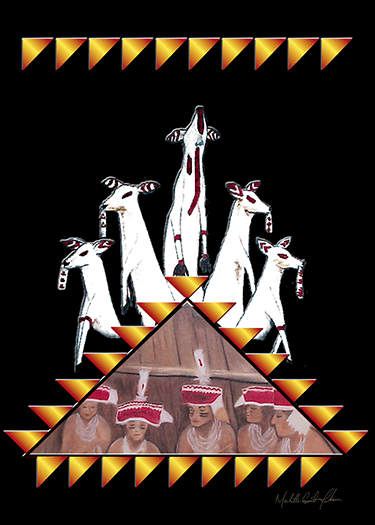
Marlette’s experience shows how negativity can be harmful. But she continued by adding that despite any negativity, it’s essential to keep going.
“Keep at it!” She insisted. “Don’t let somebody tell you [what art is]. Art is up to you.”
Melitta continued this sentiment by firmly stating: “I would say, just draw what you want or like, do what you want!”
Melitta added that frequently, there are “gatekeepers” that determine what art is or isn’t, but the important part is to remember that if people are connecting with what you are creating, that’s what matters.
“I love that people love the illustrations that we do and the designs that we make. [T]hey connect with it, whether it’s because it’s indigenous or because it feels place-based. But there [are] other things that I enjoy drawing just for the sake of drawing. I love Amanita Muscaria mushrooms, the red cap mushrooms. I just love drawing them!”
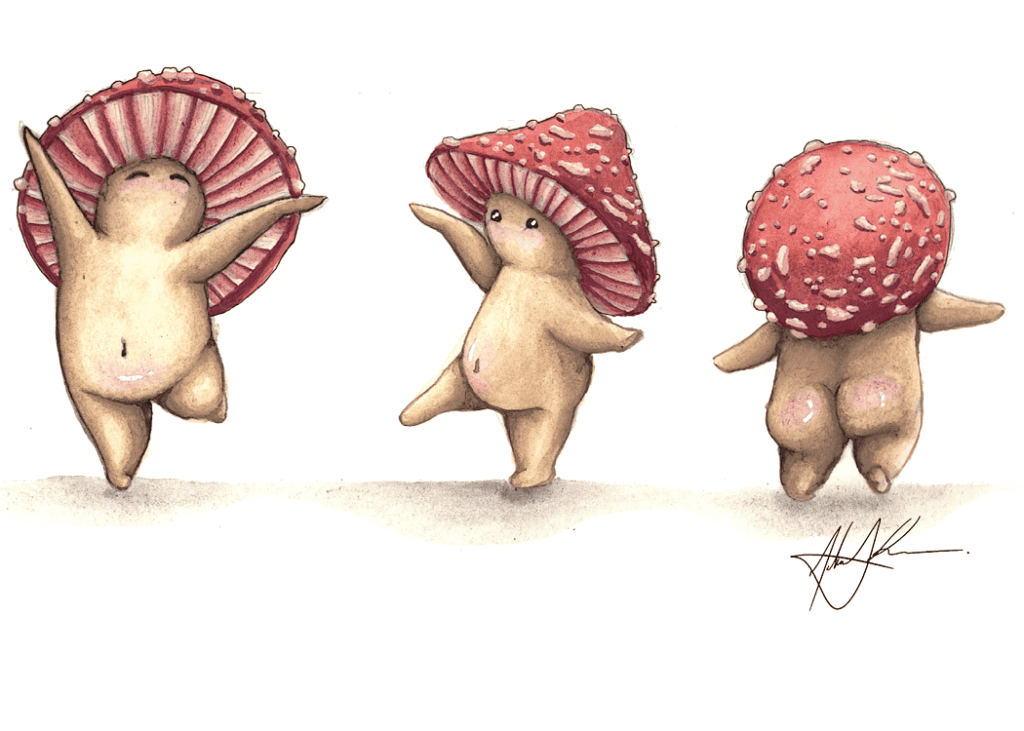
Melitta encourages artists to allow their artistry to flow through them in whatever form. Not everything needs to have cultural significance to make it valid; in fact, that kind of thinking can act as a means of stifling Native artists.
“I digitally illustrated a little Amanita Muscaria girl at one point. I love her. I put a lot of work into that piece. But when it showed in a gallery someone asked what the ‘cultural significance’ was. There isn’t. I just wanted to make something whimsical and fun. They weren’t satisfied with that answer. I’m not aware of any cultural stories around mushrooms. They’re just fun to illustrate and I constantly come back to them out of fascination.”
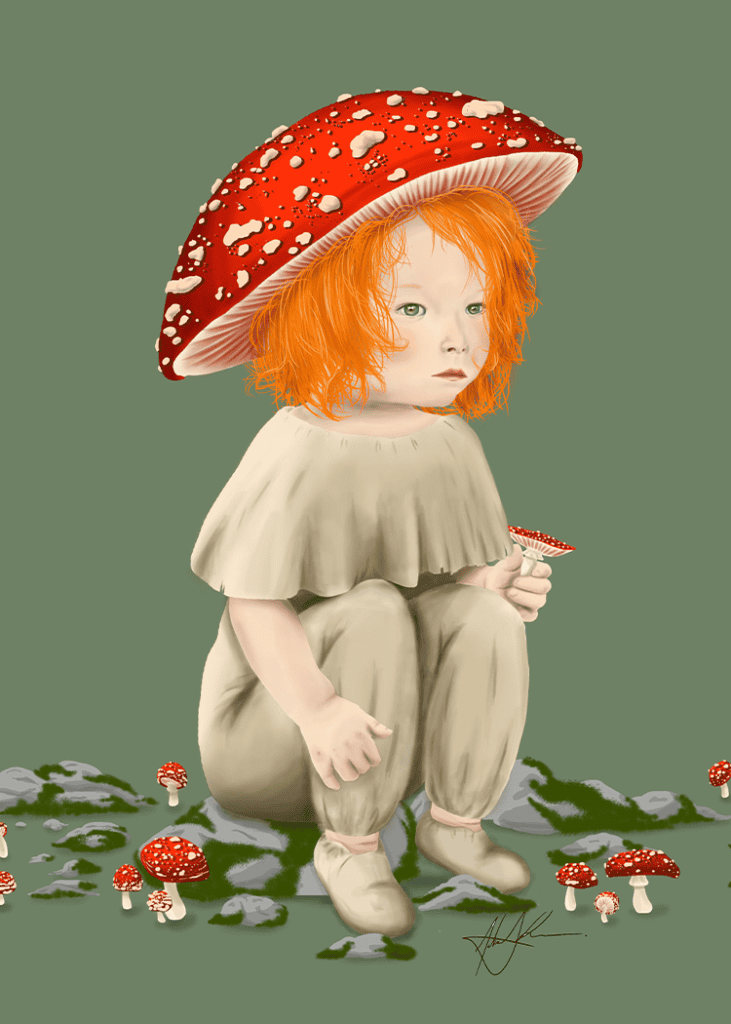
Marlette and Melitta highlight the importance of being true to yourself. Art can take many forms, but in the end, it is an expression of creativity, inherently unique to each of us, and impossible for it to be wrong.
–
You can find Marlette and Melitta’s work on their Etsy shop: https://www.etsy.com/shop/MelittaJackson?
Marlette made sure to share that if you want to add a name to a cup or have an idea for customization, reach out and ask!
You can also find Melitta on her YouTube Channel, The Midnight Librarian, where she discusses and reviews a variety of books.
Find her at https://www.youtube.com/@themidnightlibrarian5159.
You can also see more of Melitta’s work by visiting her website: https://www.melitta-jackson.com/




